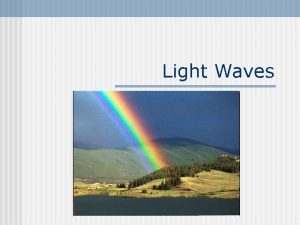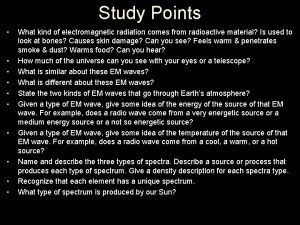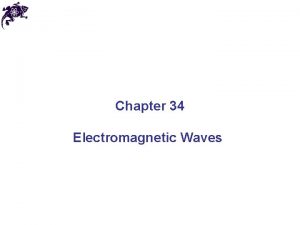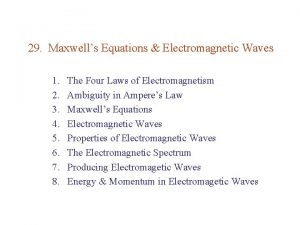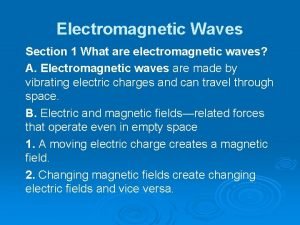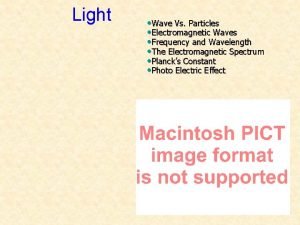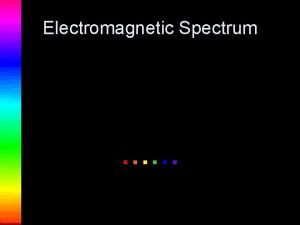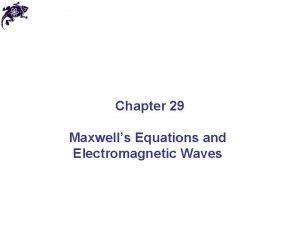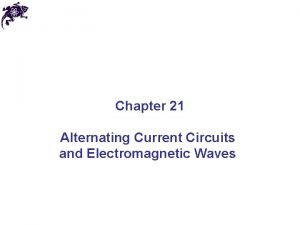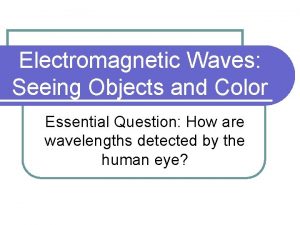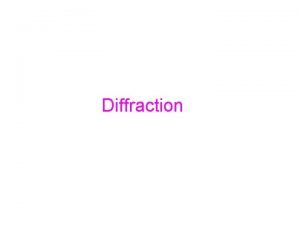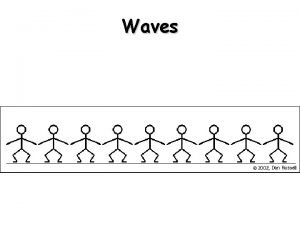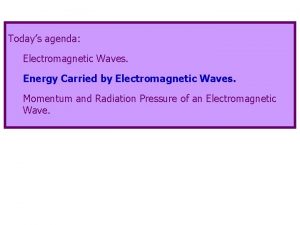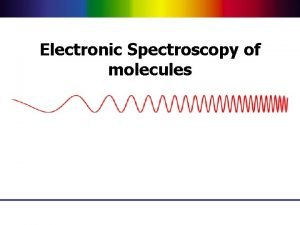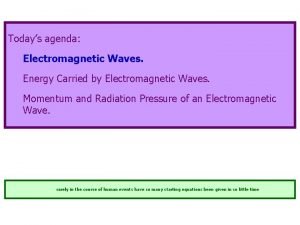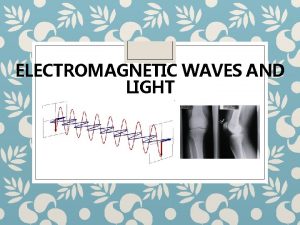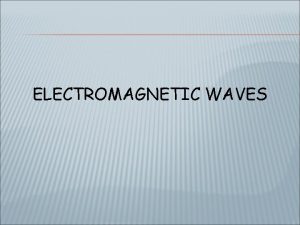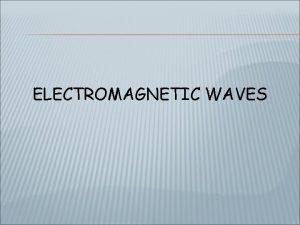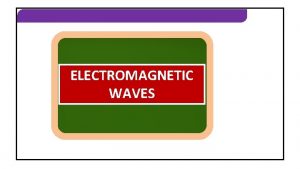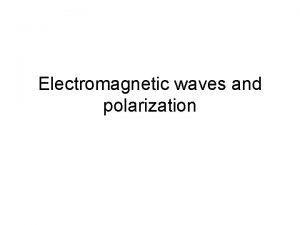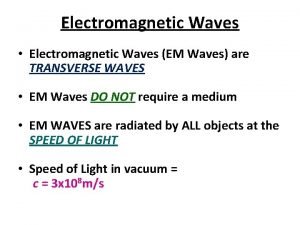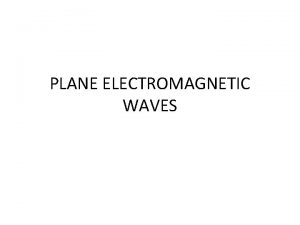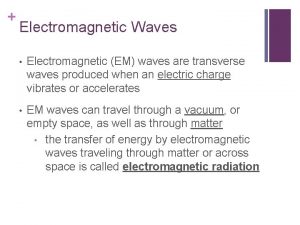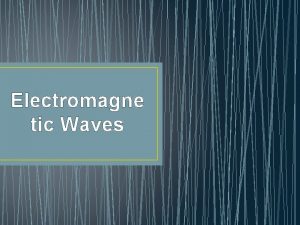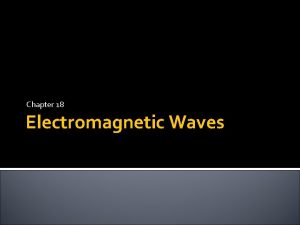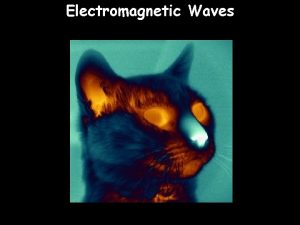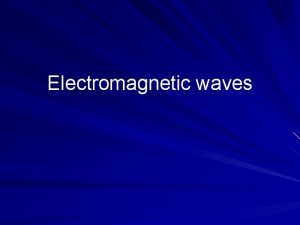Polarization Electromagnetic Waves Electromagnetic Wave EM wave is




























- Slides: 28

Polarization Electromagnetic Waves

Electromagnetic Wave

EM wave is … • Light is an electromagnetic wave. • It consists of vibrations of an electric field and a magnetic field. • The electric field and magnetic field are perpendicular to each other and in phase. • An EM wave is a transverse wave. • The speed of all EM waves is 3. 00 x 108 ms-1.

Electric Field Vector

Polarized Light Vibrations lie on one single plane only. Unpolarized Light Superposition of many beams, in the same direction of propagation, but each with random polarization.

Representation. . . E Unpolarized E Polarized

Polarization of Light

Polarizing Material A Polarizing material will only allow the passage of that component of the electric field parallel to the polarization direction of the material I = I 0 cos 2 q

Crossed Polarizers • The first polarizer reduces the intensity by half. • The second polarizer reduces the intensity by another factor of cos 2 q. • The second polarizer projects the electric field onto a new axis, rotated by q from the axis of the first polarizer

Crossed Perpendicularly

Crossed at different angles. . .

Reflection

Glares

Sunglasses – Glare Reduction • Polarized lenses have the added benefit of filtering out reflected light, or glare, off surfaces such as water or pavement • Ideal for boating, fishing, driving or any other activity associated with intense glare • Reduces eyestrain and fatigue, while increasing contrast and visual acuity

How Do Polarized Lenses Work? • Light reflected from surfaces like a flat road or smooth water is generally horizontally polarized. This horizontally polarized light is blocked by the vertically oriented polarizers in the lenses. • The result: a reduction in annoying and sometimes dangerous glare.

Action of Polaroid Sunglass Light reflected from surfaces like a flat road or smooth water is generally horizontally polarized. This horizontally polarized light is blocked by the vertically oriented polarizers in the lenses. Vertically Polarized Light from Objects Unwanted glares are usually horizontally polarized light

Glare and Polarization http: //regentsprep. org/Regents/physics/phys 04/cpolarize/glare. htm

Glare and Polarization The polaroid absorbs most of the polarized light reflected from the water’surface, allowing the dimmer light from the bottom of the river, and any fish swimming there, to be seen more readily.

Glare and Polarization www. johnsonwindowfilms. com/cutglare. htm

Glare and Reduction

Application • Used in LCD display • Electrical voltage on a liquid crystal diode turns on and off polarizing filter effect.

Seven-Segment LCD

Malus’ Law • A Polarizer by itself will only transmit 50% of the light. Therefore the intensity of the light I 1 = (½) Io, where Io is the incident light’s original intensity. • If 2 Polarizers were to be at 90 degrees to each other the emitted intensity is essentially zero. • The second Polarizer is called an analyzer.

Malus’ Law • The angle of the analyzer determines the final intensity of the emitted light, I 2 = I 1 cos 2

Example • If two Polaroids make an angle of 60. 0 o between their polarizing directions, what percentage of light is transmitted through them? I 2 = I 1 cos 2θ I 2 = (½) Io cos 2 (60. 0 o) I 2 = (½) ( ) Io I 2/Io = Therefore ____% of the light is

Brewster’s Angle • Light that is reflected can also be polarized. tan θB = n 2/n 1 • where n are the indices of refraction and θB is where 100% polarization occurs. (The angle between the reflected and refracted rays is 90 o, too)

Example • Find Brewster’s angle for an air/water (n = 1. 33) interface. tan θB = n 2/n 1 θB = tan-1(1. 33/1. 00) = 53 o

Links • http: //micro. magnet. fsu. edu/optics/lightand color/polarization. html • Blue Skies and Red Sunsets
 Difference between electromagnetic waves and sound waves
Difference between electromagnetic waves and sound waves Mechanical and electromagnetic waves
Mechanical and electromagnetic waves Do electromagnetic waves require a medium
Do electromagnetic waves require a medium Mechanical waves and electromagnetic waves similarities
Mechanical waves and electromagnetic waves similarities Transverse wave vs longitudinal wave
Transverse wave vs longitudinal wave Mechanical vs electromagnetic
Mechanical vs electromagnetic Mechanical wave examples
Mechanical wave examples Mechanical and electromagnetic waves similarities
Mechanical and electromagnetic waves similarities Em spectrum physics
Em spectrum physics Electromagnetic waves characteristics
Electromagnetic waves characteristics Doppler gamma
Doppler gamma Conclusion of electromagnetic waves
Conclusion of electromagnetic waves Hertz experiment electromagnetic waves
Hertz experiment electromagnetic waves Electromagnetic powerpoint template
Electromagnetic powerpoint template Direction of electromagnetic waves
Direction of electromagnetic waves Section 1 what are electromagnetic waves
Section 1 what are electromagnetic waves Electromagnetic waves frequency
Electromagnetic waves frequency Electron spectrum
Electron spectrum Teoria de james maxwell
Teoria de james maxwell Electromagnetic waves vocabulary
Electromagnetic waves vocabulary Section 1 what are electromagnetic waves
Section 1 what are electromagnetic waves Concept of electromagnetic waves
Concept of electromagnetic waves Alternating current circuits and electromagnetic waves
Alternating current circuits and electromagnetic waves Electromagnetic waves: seeing objects and color
Electromagnetic waves: seeing objects and color Diffraction ocean waves
Diffraction ocean waves Electromagnetic energy
Electromagnetic energy Energy density of em waves
Energy density of em waves Electromagnetic spectrum
Electromagnetic spectrum Energy carried by electromagnetic waves
Energy carried by electromagnetic waves









